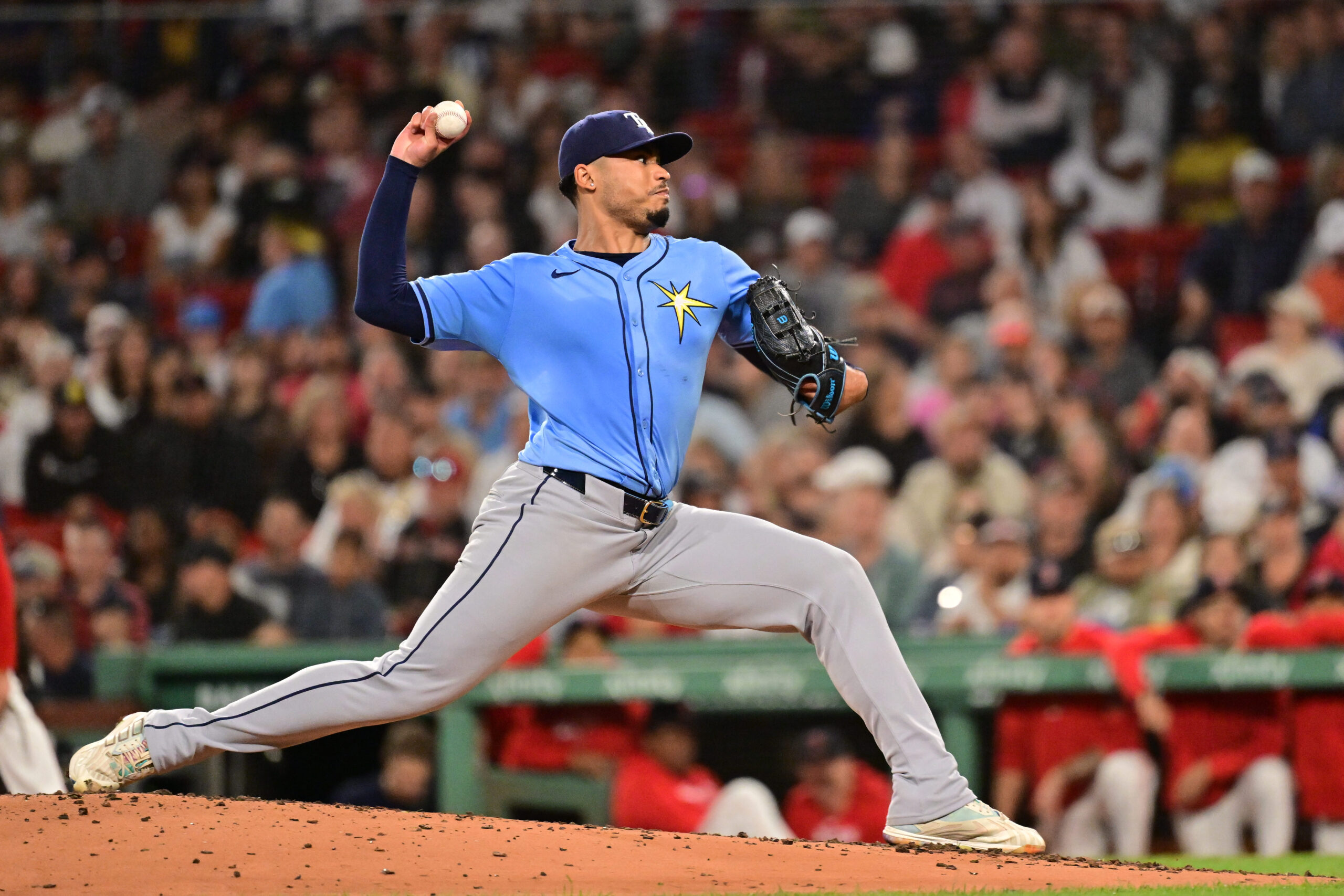Evaluating how young starting pitchers make adjustments and improve in the big leagues is fascinating to see unfold. Sometimes it doesn’t all click at once, but there are still incremental improvements. This, in a way, applies to Tampa Bay Rays starter Taj Bradley. Bradley struggled a bit in his rookie season, with a 5.59 ERA and 1.385 WHIP across 104 2/3 innings. However, he did display some intriguing upside in his peripherals, posting a top 30 mark in K-BB%, one of the more effective statistics for evaluating pitchers. Furthermore, other advanced statistics, including FIP and SIERA, suggested he was pitching better than what his ERA would indicate.
Young Rays Starter Taj Bradley Making Strides
Along with supportive peripherals, Bradley popped Stuff+ as a rookie. His net 110 Stuff+ number was in the top 20 among all starting pitchers in baseball (minimum 100 innings). In addition, his four-seam fastball graded out as the 2nd best, ranking only behind strikeout artist Spencer Strider. But Bradley was left searching for answers as to how to best complement this elite fastball in the rest of his arsenal as he struggled with keeping the ball in the ballpark. Hitters were able to key in on his fastball, and he did not have another pitch he was confident in. Combined with shaky command, it was an up-and-down rookie season but left plenty to be excited about.
Secondary Improvements
Taj Bradley used a splitter, cutter, and a curveball off of his fastball in his rookie season. He maintained this same repertoire into 2024 and altered the usage. In his rookie season, he got crushed by same-handed hitters, allowing over a .600 SLG. A lot of this could be attributed to him not having a strong breaking ball or slider that he trusted. He used his cutter frequently and, due partly to his command limitations, allowed a lot of damage in the zone.
Cutter
Coming into 2024, the Rays had Bradley throw his cutter harder along with shifting the seam orientation. After being 88.9 MPH in his rookie season, he ticked it up to 90.9 MPH. As a result, this harder velocity added vertical break to his cutter and it became a better pitch. After allowing a .581 SLG with a .501 xSLG on the pitch as a rookie, he minimized the damage with a .357 SLG and .359 xSLG in 2024. His ground ball rate on the pitch also improved from 41.3% to 53.7%. Furthermore, he created more whiffs on the pitch going from a 30% whiff rate to 32.4%. So, it was more effective at limiting damage and also inducing swing and miss.
Taj Bradley, Filthy 90mph Cutter. ✂️ pic.twitter.com/TT9vjzSNMl
— Rob Friedman (@PitchingNinja) August 12, 2024
Splitter
Alongside his new and improved cutter was Bradley’s splitter. After using the splitter the least amount of any pitch as a rookie (13.6%), Bradley used the pitch as his main secondary offering alongside his cutter. Notably, he significantly increased his splitter usage against right-handed hitters from 5.3% as a rookie to nearly 20%. He cut his curveball usage in half to both sides in favor of his splitter. It was an excellent out pitch for him and it performed well in terms of generating whiffs and limiting damage. Additionally, his splitter graded out very well by Stuff+ at 123. It ranked as the 2nd best splitter among all starters in baseball (minimum 100 innings). To summarize, Taj Bradley has the 2nd best fastball and splitter by Stuff+. Factoring in his improved cutter, he now has an impressive mix that can get hitters out in different ways.
Ups And Downs
After missing the first six weeks of the 2024 season with a pectoral injury, Bradley made his season debut in early May. As he progressed and got back to full strength, he went on an extended heater. In the months of June and July, Bradley posted a 2.56 ERA and 1.042 WHIP with a strikeout rate of 29.2%. This put him among the best during that time span and everything was seemingly coming together for the young righty. While he had solid peripheral numbers during this time, there were signs of good fortune as almost any hot streak has. Bradley had a good but not great 13.5% swinging strike rate along with a BABIP of .236, which was one of the ten lowest in this time frame. However, he did well limiting damage with a .276 xwOBA and keeping the ball on the ground at 47.8%. Then, the volatility of his profile kicked back in for the rest of the season.
From August until the end of the season, Bradley’s results were as poor as they were excellent earlier in the year. His 6.45 ERA during this span was third worst and his 1.587 WHIP was the worst (minimum 50 innings). His strikeout rate cratered down to an average 21.7% and his quality of contact allowed skyrocketed. Importantly, the impressive numbers Bradley had with his splitter against right-handed hitters completely flipped. In this time frame, while it produced a good amount of whiff, it induced an xwOBA of .452. Comparatively, during his good stretch, it allowed a .178 xwOBA to right-handed hitters. On the other hand, his fastball was getting crushed to a frighteningly similar .451 xwOBA against left-handed hitters in this span. The damage given up on his fastball is not a new story for Bradley, as he can have trouble locating it consistently at the top of the zone. But, we have two very different versions of splitter performance against same-handed hitters.
Future Outlook
Despite the shape of Bradley’s season ending poorly, there were still clear signs of progression. The development of his cutter and splitter was pivotal for him to reach his ceiling. Both appear to be quality offerings that can work against hitters from both sides. The issues he had with the splitters to right-handed hitters have much to do with him not locating it in the zone and hitters taking advantage of him leaving it elevated. Since he has average to below-average command combined, the long ball will likely continue to be an issue for him. But there are more than enough positives in his profile to compensate for that. Being coached and developed by a great organization like the Tampa Bay Rays is a benefit as well. Given his premium stuff and youth, Taj Bradley has all the tools to become a frontline starter in the future.
Main Photo Credits: Eric Canha-Imagn Images






